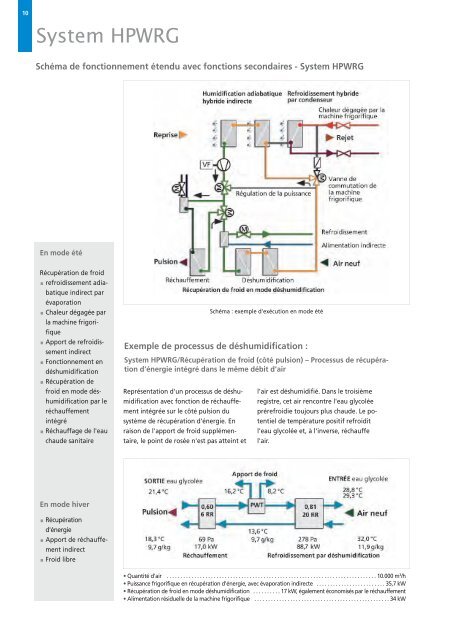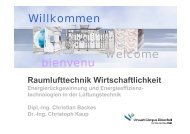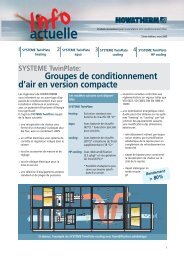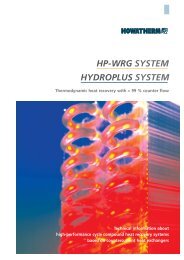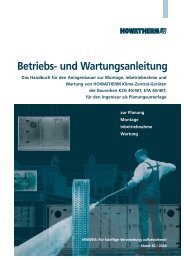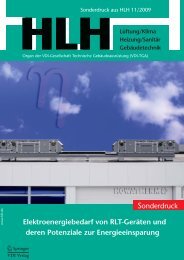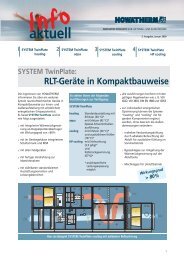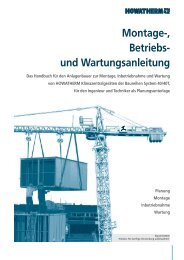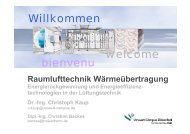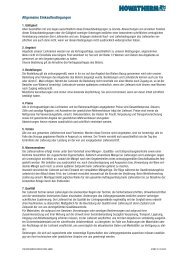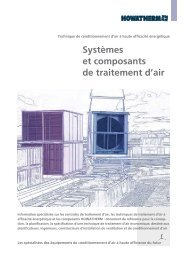Systèmes de récupération d'énergie à haute ... - HOWATHERM
Systèmes de récupération d'énergie à haute ... - HOWATHERM
Systèmes de récupération d'énergie à haute ... - HOWATHERM
You also want an ePaper? Increase the reach of your titles
YUMPU automatically turns print PDFs into web optimized ePapers that Google loves.
10<br />
System HPWRG<br />
Schéma <strong>de</strong> fonctionnement étendu avec fonctions secondaires - System HPWRG<br />
En mo<strong>de</strong> été<br />
Récupération <strong>de</strong> froid<br />
refroidissement adiabatique<br />
indirect par<br />
évaporation<br />
Chaleur dégagée par<br />
la machine frigorifique<br />
Apport <strong>de</strong> refroidissement<br />
indirect<br />
Fonctionnement en<br />
déshumidification<br />
Récupération <strong>de</strong><br />
froid en mo<strong>de</strong> déshumidification<br />
par le<br />
réchauffement<br />
intégré<br />
Réchauffage <strong>de</strong> l'eau<br />
chau<strong>de</strong> sanitaire<br />
En mo<strong>de</strong> hiver<br />
Récupération<br />
<strong>d'énergie</strong><br />
Apport <strong>de</strong> réchauffement<br />
indirect<br />
Froid libre<br />
Représentation d'un processus <strong>de</strong> déshumidification<br />
avec fonction <strong>de</strong> réchauffement<br />
intégrée sur le côté pulsion du<br />
système <strong>de</strong> <strong>récupération</strong> <strong>d'énergie</strong>. En<br />
raison <strong>de</strong> l'apport <strong>de</strong> froid supplémentaire,<br />
le point <strong>de</strong> rosée n'est pas atteint et<br />
Schéma : exemple d'exécution en mo<strong>de</strong> été<br />
Exemple <strong>de</strong> processus <strong>de</strong> déshumidification :<br />
System HPWRG/Récupération <strong>de</strong> froid (côté pulsion) – Processus <strong>de</strong> <strong>récupération</strong><br />
<strong>d'énergie</strong> intégré dans le même débit d'air<br />
l'air est déshumidifié. Dans le troisième<br />
registre, cet air rencontre l'eau glycolée<br />
prérefroidie toujours plus chau<strong>de</strong>. Le potentiel<br />
<strong>de</strong> température positif refroidit<br />
l'eau glycolée et, <strong>à</strong>l'inverse, réchauffe<br />
l'air.<br />
• Quantitéd'air ............................................................................10.000m 3 /h<br />
• Puissance frigorifique en <strong>récupération</strong> <strong>d'énergie</strong>, avec évaporation indirecte . . . . . . . . . . . . . . . . . . . . . . . . . 35,7 kW<br />
• Récupération <strong>de</strong> froid en mo<strong>de</strong> déshumidification . . . . . . . . . . 17 kW, également économisés par le réchauffement<br />
• Alimentationrésiduelle<strong>de</strong>lamachinefrigorifique .................................................34kW


